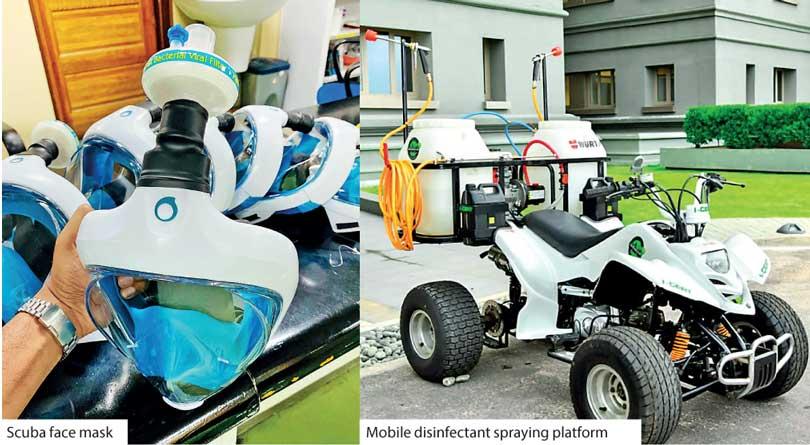19 May 2020 - {{hitsCtrl.values.hits}}

 Sri Lanka’s COVID-19 outbreak has indicated a silver lining. In fact, it has paved the way for budding inventors to put their knowledge into good use during the lockdown period to innovate new equipment to help medical staff and other officials in the frontlines to battle against the deadly virus.
Sri Lanka’s COVID-19 outbreak has indicated a silver lining. In fact, it has paved the way for budding inventors to put their knowledge into good use during the lockdown period to innovate new equipment to help medical staff and other officials in the frontlines to battle against the deadly virus.
So far the Sri Lanka Inventors Commission (SLIC) has received over 250 such inventions where some are being evaluated while others have been patented or already sent for production.
Under the COVID-19 inventions tab in the SLIC website, one could witness the equipment from automated hand sanitizer to microorganism killing and filtering air conditioners, foot-operated door handles, low-cost open-source ventilators and many more.
Hence, Daily Mirror sheds light on a few new innovations and the role of SLIC in the fight against COVID-19.
It’s comfortable to be worn with standard goggles and N95 face shield has better filtration. The air intake is from the back of the mask so I can face the patient with less droplet intake. Another benefit is that it’s reusable
Scuba face mask
“It’s very uncomfortable to wear PPEs and then I remembered this mask,” said Dr Lakmal Fernando working at the Sri Jayewardenepura Hospital ICU.
“Then I asked a friend working at Decathlon to give me three masks for an experiment. With this mask, we don’t have to wear PPEs because it has a standard 22mm ventilator tubing adaptor which uses a standard ventilator bacterial and viral filter which filters inhaling and exhaling air.
“It’s comfortable to be worn with standard goggles and N95 face shield has better filtration. The air intake is from the back of the mask so I can face the patient with less droplet intake. Another benefit is that it’s reusable. It’s currently being used at the Jayewardenepura Hospital and National Hospital.”
Disinfection chamber
As discussions are underway to restore normalcy in the country, many institutions are following health directives given out by the Health Ministry. Other than washing hands and checking temperature, many institutions are now in the process of installing disinfection chambers. With the growing demand, those chambers are now being locally produced.
“The chambers are being constructed with the knowledge and expertise of microbiologists and technical experts,” said Sri Jayewardenepura, Kotte mayor Madura Withanage.
“What’s special about these chambers are that one litre of disinfectant can be sprayed on around 80 people. It has been automated so that once someone leaves the chamber the spray turns off. We also put special attention on the alcohol content as a specific amount is required to kill the protein in the virus.
It has also been tested for fire safety because with the usage of alcohol there’s a risk of surfaces catching fire. While 15% of the disinfectant is sprayed on people, the remaining 85% is air pressure. This way it’s the vapour that gets absorbed to the skin in a limited quantity.”
Withanage plans to produce these chambers and give away to institutions that carry out essential services. He also said that plans are underway to redesign the municipality for a post-COVID-19 era for people to maintain social distancing in populated spaces until a vaccine is in place.
Mobile Disinfectant Spraying Platform
As a 100% voluntary organisation, the Ironman 4x4 Community Emergency Response Team (I-CERT) Sri Lanka is dedicated to extending their support at times of disaster. Recently, they handed over a mobile disinfectant spraying platform to the Army commander to assist Army officials to reach out to densely populated areas in the city. “Our members are trained in CPR and first aid by the Japanese government,” said Sam Chandrasoma, Chairman, Team Ironman 4x4 Sri Lanka and I-CERT.
“When the COVID-19 outbreak happened there was little we could do to assist relief efforts. But our strength is our vehicles. Our vehicles can go in any terrain and can approach areas where other vehicles usually cannot approach. So I got in touch with the Research and Development department at the Ministry of Defence and we wanted to develop a vehicle that could carry chemicals in a larger area with less human interaction. So we bought an all-terrain vehicle and did a lot of modifications so that it could carry around 200 kg at the back. We added two nozzles to the tanks that are adjustable according to height, spray pattern and angle. It could be remote-controlled; so you can stop the unit at one point and it works like how two vipers would operate except that they are in opposite directions. It could cover an area of 3-4 km. There’s a handgun attached as well so you could stop anywhere and spray a 25 feet radius. I like to thank General Pradeep De Silva and General Renuka Rowell for placing their trust in us and accepting our vision.”

We started calling out for new inventions and we created an online database with over 250 inventions
Prof. Rangika Halwatura
Inventors empowered
As the apex body for identifying new inventors and giving out patent rights, the SLIC has launched its campaign for the fight against COVID-19 since March 23. “We started calling out for new inventions and we created an online database with over 250 inventions,” said Prof. Rangika Halwatura, SLIC Commissioner.
“We firstly recorded the inventor’s details and for each invention, we allocate an official from the SLIC to check its daily progress. We check for the status of the inventions, its significance to fight COVID-19 and so on. With the assistance of the National Intellectual Property Office (NIPO) inventors can now apply for patents online. So before taking the invention anywhere, we do the patenting. Then we group the inventors depending on their backgrounds.
“We then send the invention for testing at different facilities from Sri Lanka Institute of Nanotechnology (SLINTEC), National Institute of Fundamental Studies, University laboratories etc. We use the National Engineering and Research Development Centre (NERD) to make a prototype. So far we have done five evaluations and more than 50 inventions have been sent for prototyping. When it comes to commercialising we either link the inventor with a company or empower them to become entrepreneurs.”
He said that this process shouldn’t die down. “Initially inventors were not given due recognition because they couldn’t develop an invention to address a community issue. Inventors have also tried to work as individuals. But this time, both these barriers have been broken because they had to work as a team and they were accepted by the community.”
28 Nov 2024 23 minute ago
28 Nov 2024 26 minute ago
28 Nov 2024 41 minute ago
28 Nov 2024 2 hours ago
28 Nov 2024 2 hours ago